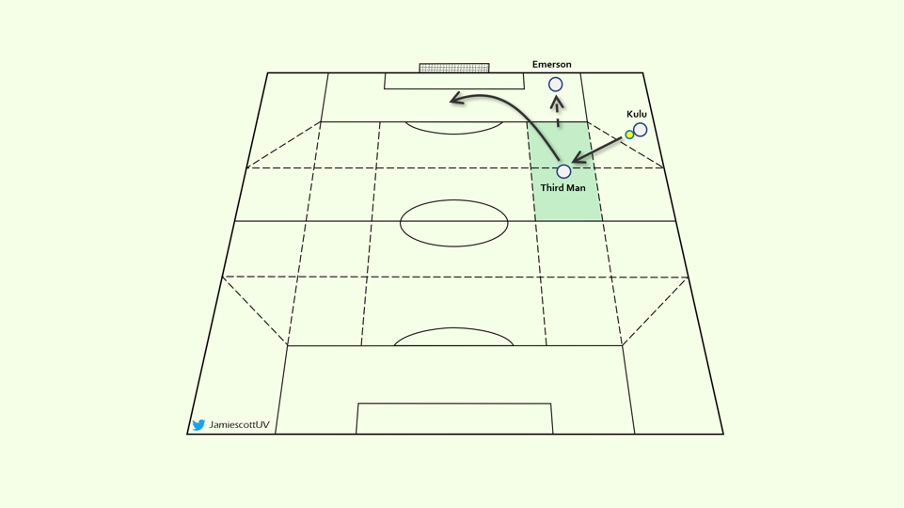Jamie Scott assesses the Swedish playmaker’s unorthodox method and how it benefits Tottenham Hotspur
Dejan Kulusevski’s stint at Tottenham, under Italian manager and notorious serial winner Antonio Conte, has been an unequivocal success so far. The Swedish attacker has contributed to his side’s revival under Conte and subsequent top four finish last season and has started the 2022/23 season in a similarly rich vein of form.
Kulusevski’s output may make the headlines: he has obvious quality as a technically sound inverted winger in a classic Antionio Conte front three, which uses such players well. But, a deeper dive into Kulusevski’s style of play unearths some very interesting facets to his game, which suggest that he isn’t another run-of-the-mill inverted winger, but rather a unique, if unpredictable, but highly efficient player.
Creation and Threat from a Holistic Perspective
To appreciate the nuanced game of Dejan Kulusevski, it is important to zoom out and revisit football from a more holistic, tactical perspective. Many coaches break the pitch down into five zones spanning the pitch laterally, the central zone and two wide zones sandwiching the half-spaces. This is common practice and fairly objective; we know many elite-level coaches view the football pitch in this manner. There is certainly room for interpretation surrounding the individual value of each zone though, in terms of potential threat when in-possession of the ball in a given zone. This level of perceived threat often dictates how teams play, for example the zones they try to access with the ball, or the zones they defend as a matter of priority. Likewise, appreciation of the zones on a football pitch is important for players on an individual level too. The wide zone, for example, is easy to receive in because a player won’t receive 360 degree pressure (due to the sideline), while the central zone is often congested by opposition defenders.
Taking the holistic understanding of zones, and a practical understanding of how different systematic and individual factors interplay to create dynamics on the pitch, we can form a picture of each zone’s advantages and disadvantages and the risks and potential rewards of running possession through them. Below is a graphic which outlines some zones of interest, in terms of ball possession and chance creation.
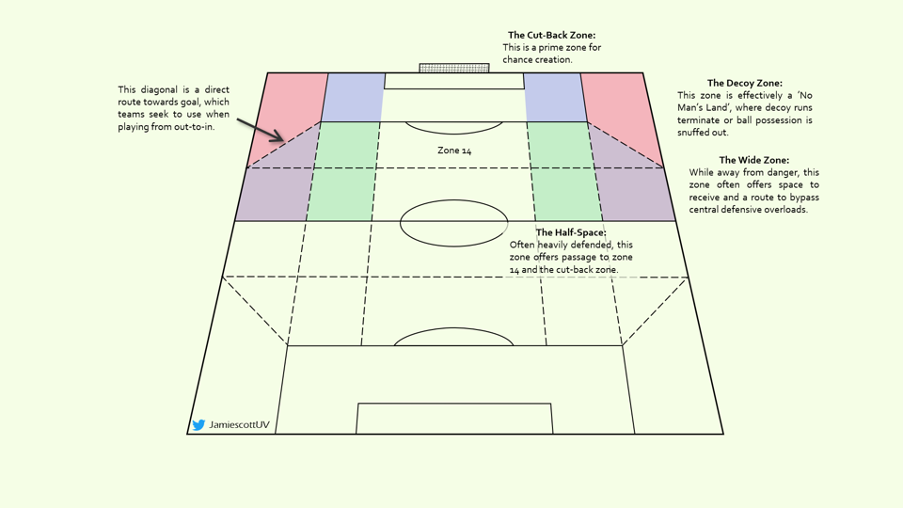
We know that Expected Goals (xG), and by association threat in possession, increase in a linear manner as you move from a wide zone to a central zone; it’s easier to score from closer in and having a better angle of the goal, two facets improved by centrality. The zones in the penalty area, wide of the six-yard box, are becoming increasingly used as ‘cut-back’ zones, most notably by Pep Guardiola and his Manchester City. Teams use a number of strategies to distort the opposition defensive block, in order to enter this zone and engineer high xG finishing chances for their attackers via cut-backs. Zone 14 is also a high threat zone, obviously because it is central and close to goal, but teams are often strong at defending this zone, which reduces its potency as an area to target repeatedly in possession to create a sustainable stream of chances game to game. Teams are becoming stronger defensively: more tactically informed, physically fit and well-drilled. The essence of sustainable chance creation therefore seems to be creating from zones which offer both high volume access and high threat.
In other words, the teams that sustainably threaten in possession use zones which allow them to create both a high quantity and high quality of chance. Enter, the half-space. The half-space is a perfect middle ground (literally) between the wide zones (which teams often use to progress possession into the final third), and the ultra-threatening zones (the cut-back zone, for example). From looking at elite-level Premier League teams and their Expected Threat (xT), we can actually see that top teams actively use the half-spaces as a means to threaten and subsequently create chances.
And this is where the relevance lies when we circle back to Dejan Kulusevski, a left-footed winger, who is used on the right of a narrow front three.
Dejan Kulusevski has very impressive stats when it comes to creating for his teammates. His assists per 90 are in the 99th percentile for wingers and forwards in the top five leagues, a number backed up by his Expected Assists (xA) per 90, which are in the 77th percentile. This level of high performance checks out when viewing footage of the player; he’s obviously a high calibre operator. But what is interesting is the relationship between Kulusevski’s creation quantity and his creation quality. His Shot-Creating Actions volume is only in the 46th percentile. His dribbles per 90 is only in the 58th percentile, which errs on the lower side of what one might expect when combining footage of this player with his creation numbers. Even when it comes to shooting, Kulusevski’s volume is of a lower percentile than the quality of his shots; he is in the 40th percentile for shots taken per 90, but his xG per 90 is 56th percentile.
The summary of this first-look at Kulusevski’s data is that he is a high producer of high quality chances, a notion made all the more impressive because this isn’t done through sheer volume. This summary, of course, begs the question: how does Kulusevski make so much out of very little? And furthermore, is this interpretation of the data valid? This article will proceed to answer these questions.
Where Does Kulusevski Receive Possession?
In order to get a feeling for how Dejan Kulusevski plays, we can first look at the positions the player receives possession in, and the manner in which he receives. For a winger, receiving the ball is an important, if slightly overlooked, facet.
For an inverted winger (a winger playing on the opposite wing to their strong foot), adopting an inside position has become the convention. The winger will invert in order to operate closer to goal, and to create space for an overlapping fullback/wingback. This is no less prominent when a team utilises a 3-4-3 formation; the wingbacks are expected to control the wide zone almost single-handedly, while the wingers act as wide forwards.
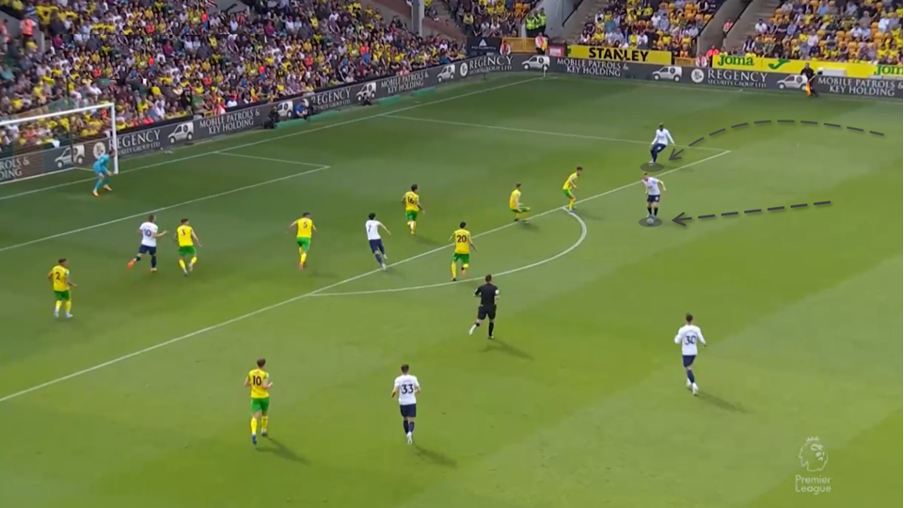
Viewing Kulusevski closely, however, has unearthed an interesting aspect to his style of play: he doesn’t tend to invert that often. More specifically, Kulusevski doesn’t invert to receive the ball anywhere near as much as you’d expect from a left-footed winger on the right. Quite frequently, Kulusevski is seen peeling completely wide in order to receive.
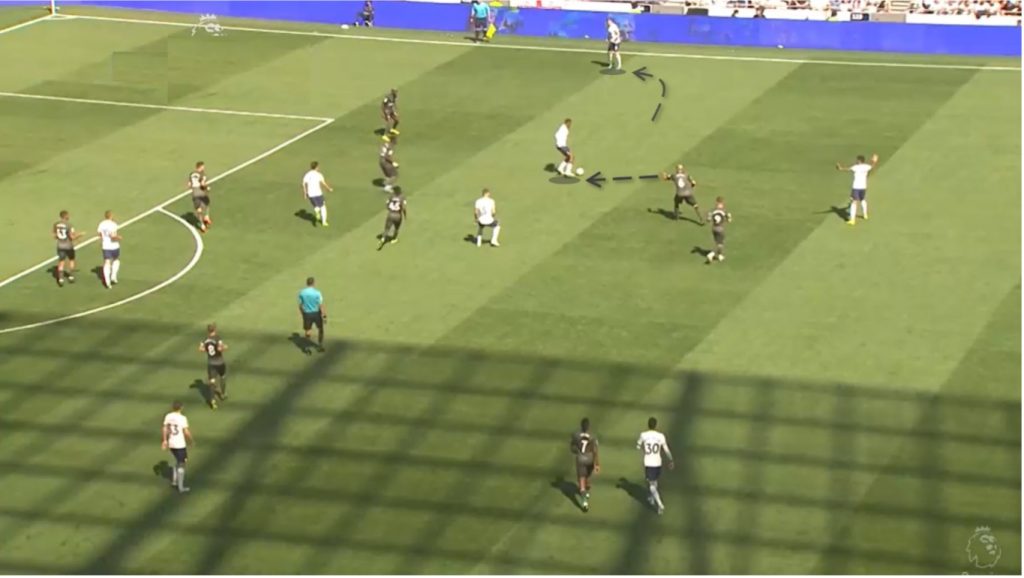
It seems counter-intuitive for Kulusevski, and by extension Spurs, to play like this from a threat standpoint; you’d surely want your high-quality forward to receive in positions closer to goal. This notion is somewhat backed up by his Involvement Map, below.
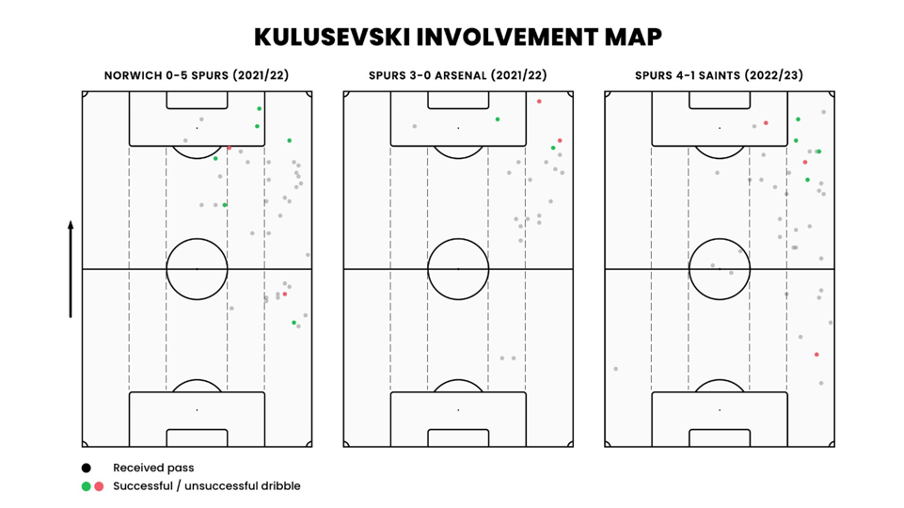
From this map we can see that Kulusevski does have a proclivity to invert to receive, but largely, he receives in the wide zone. There is some noise in the data, simply due to it being game-to-game, and each opposition posing its own unique challenge, but this data is still representative of Kulusevski’s style of play.
In isolation, receiving the ball doesn’t seem to be a glamourous, if even important factor of play for an individual. But on the contrary, particularly as a winger (or forward), having the ability to dis-mark (making feints/decoys to eventually receive under less pressure from defenders) and receive the ball is the start-point for any winger’s game if they aim to generate threat or create chances through carries or dribbles. By peeling so wide, Kulusevski has the opportunity to receive possession in most games, and can begin to make a notable impact. For this reason, he is rarely seen completely uninvolved in a match, due to being crowded out or too tightly marked. Simply having the ability to receive is an important facet, but there is a finer art to this, and by digging into this we can begin to see how Kulusevski turns receiving in low threat positions into adding attacking value to his team.
How Does Kulusevski Generate Threat and Add Value?
Kulusevski doesn’t rack up a scintillating volume of dribbles per 90, yet still provides such a high number of assists, so how does he bridge the gap from receiving in wide positions to creating dangerous situations? One way he does this is in the manner in which he receives possession.
The angles at which a player receives possession is a very nuanced factor, a micro-action as such. It is easy to overlook the specifics, just like it is easy to oversimplify it by merely calling a player good or bad at receiving possession. But for Kulusevski, the angles in which he works at and the orientation of his body in relation to defenders are his bread and butter; they allow him to increase his percentage success at receiving and add value to his time in possession. In the example below, we can see a typical example of body-orientation that Kulusevski takes up when receiving.
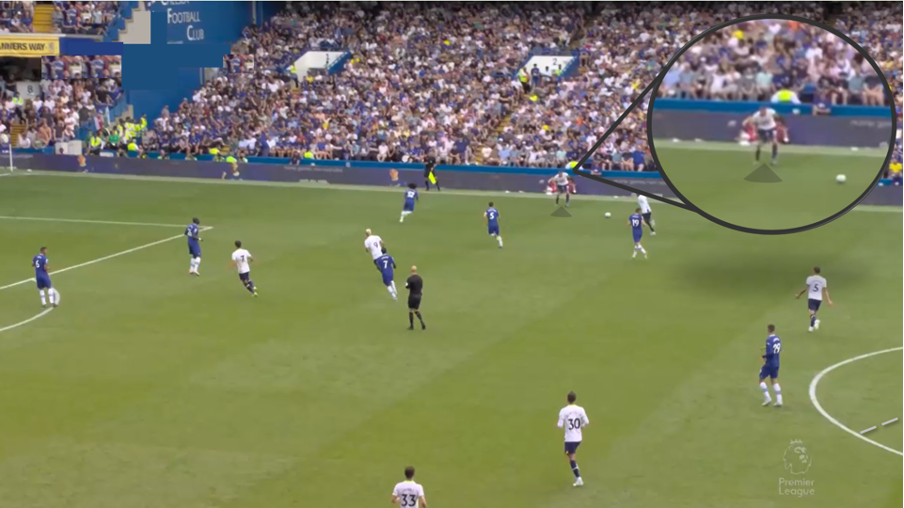
Given that the pressure from Chelsea’s defender (Cucurella) will arrive for Kulusevski’s second touch, Kulusevski knows he doesn’t have to receive back to goal, in order to shield the ball. Rather, he optimises this scenario by receiving side-on, allowing him to do two key things:
- Scanning
By receiving side-on, Kulsevski is able to scan for pressure without detracting from his focus on the ball; he can use his peripheral vision to form a mental snapshot of the defender’s positioning, and by extension their momentum, intensity of pressure, and so on. This allows Kulusevski to make the best informed decisions on the ball: he can decide what type of first touch to take (for example into space, tight to his body, looking to bait the defender in, and so on).
2. Initiate his action
The practicality of receiving in such an open, side-on stance is plainly obvious. Kulusevski can seamlessly begin his dribble (or whatever other action he wants to make, such as a round-the-corner pass, wall-pass, or combination). In one touch he can have already squared up the defender, and he still holds the side-on orientation which allows him to cut-in or go down the line. There is no sense of inevitability when Kulusevski goes down the line, because he is simply so unpredictable in his style of dribbling; this level of decoy certainly works in his favour when he looks to beat defenders with feints or other actions.
Under the presumption that Kulusevski has adhered to these two aspects, we can assume that he is in the best space mentally and practically to start creating attacking threat. Using the Involvement Map shown above, we can see that Kulusevski tends to receive the ball deep and wide, but initiates many of his dribbles high and wide. The nature of his side-on body orientation helps to facilitate the move from receiving to engaging a defender in a dribble. Kulusevski often shuffles the defender down the line, almost strafing in that side-on stance before dragging the defender into the ‘Decoy Zone’.
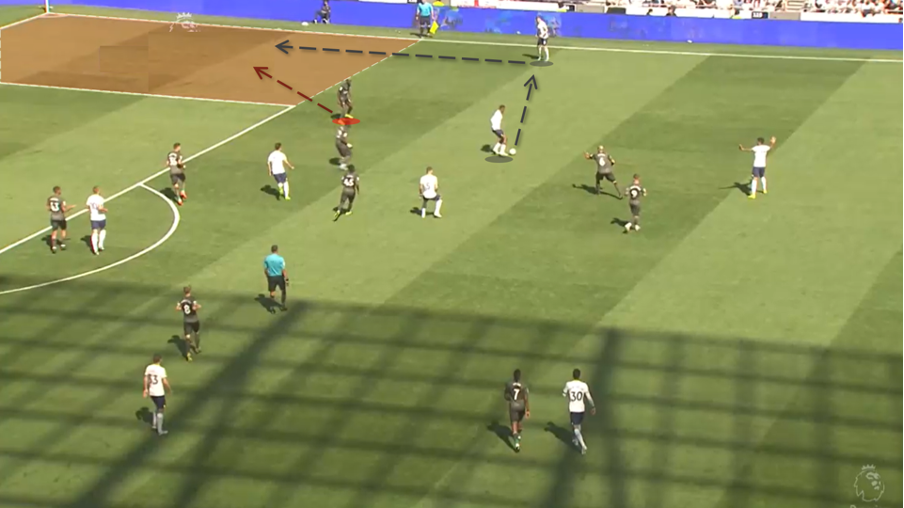
And once Kulusevski drags defenders into the ‘Decoy Zone’, he goes in for the kill. He is so successful at beating players 1v1 once he’s engaged them in this zone, such is his ability in not only 1v1 scenarios, but scenarios where he can use feints and quick feet to disarm the defender in order to create the room to beat them in the duel. The numbers back up the notion that Kulusevski likes to dribble in and around the ‘Decoy Zone’ specifically, as shown below.
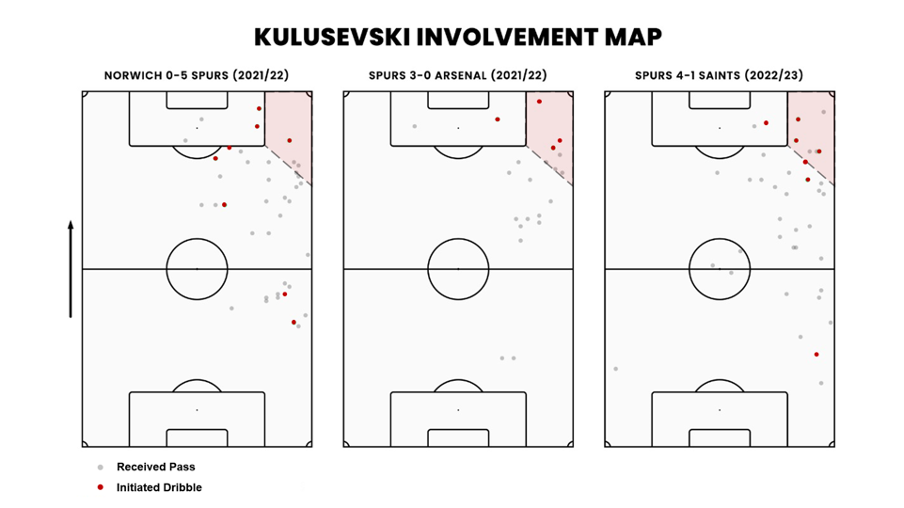
Eight of Kulusevski’s 20 total dribbles (40% of his total dribbles) in the three selected games were initiated in the ‘Decoy Zone’, while 12/20 dribbles (60% of his total dribbles) were initiated within a 5-metre proximity of the zone.
A perfect example of many of the aforementioned facets at play are on show in the clip below: Kulusevski holds wide and shuttles down the line, receives side-on, drags the defender 1v1 into the ‘Decoy Zone’ and beats him, which thus allows Kulusevski to hop from a low value zone into the cut-back zone.
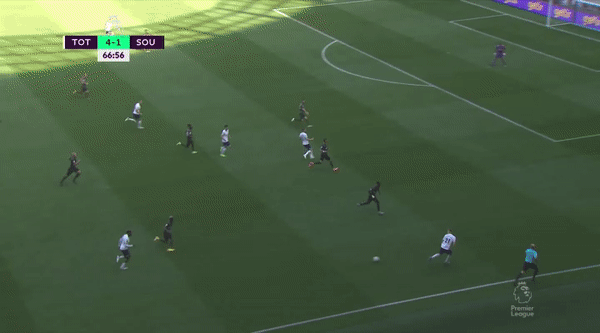
The only drawback to this example is that the defending is suboptimal: Kulusevski isn’t tightly marked and the defensive block isn’t perfectly settled. But the beauty of Kulusevski’s unpredictable style of receiving and dribbling is that defenders often can’t pre-empt what Kulusevski will do, which makes it hard for secondary defenders to cover for their teammate who has been dragged into a 1v1 by Kulusevski. Furthermore, it is highly undesirable for the defensive team to have two players be dragged into the high and wide ‘Decoy Zone’.
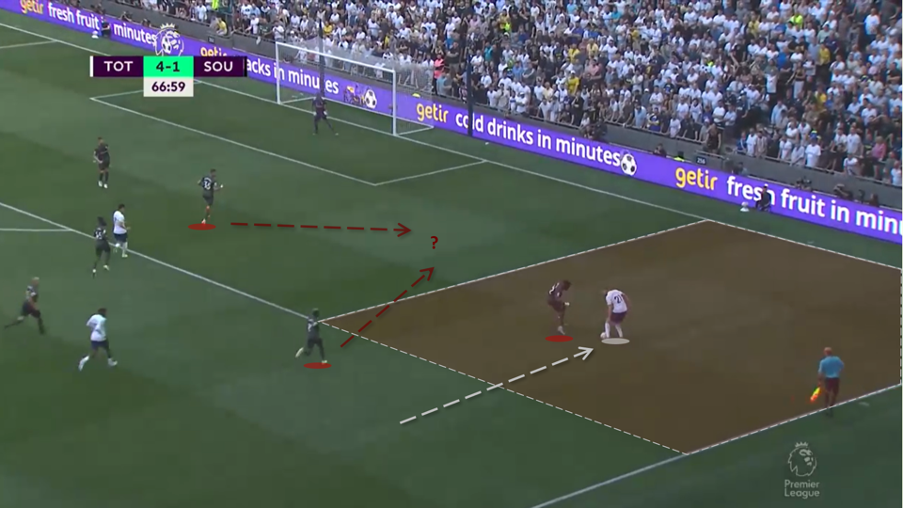
As a result of Kulusevski micro-actions and unpredictable style of play, he is essentially able to hop from receiving in the wide-zone, via the decoy zone, into the high value cut-back zone. It is unique, and stunningly effective.

Downstream dynamics
There are a number of downstream benefits to Kulusevski’s style of play too; his net positive effect isn’t limited to mere chance creation. Kulusevski’s willingness to hold width and then attack space in behind has a profound effect on the opponent’s defensive block: it distorts their shape as one of their defenders must commit to ultimately engaging Kulusevski in the wide zone.
Furthermore, Kulusevski’s willingness to attack the ‘Decoy Zone’ allows the wingback (usually Emerson Royal) to make underlapping runs in the half space. Spurs are no strangers to using underlaps to open passing/crossing lanes; last season we often saw the left-centreback Ben Davies make underlapping runs from deep to open the crossing lanes for Sergio Reguillon, the left-wingback. Indeed, while the use of inverted full backs in deeper areas has been commonplace for a few seasons, wing-backs are increasingly being used more aggressively in underlapping positions to create chances or shooting opportunities as a late-arriving, spare man.

In this scenario, the dynamic relationship between Emerson and Kulusevski means that Emerson can be found in the cutback zone by a reverse pass from Kulusevski, or Kulusevski can treat Emerson as a decoy and cut in to execute a cross on his stronger left foot. It’s a win-win when it all goes to plan, which it often does in a side as well-drilled as Antonio Conte’s Spurs.
Furthermore, with Kulusevski peeling wide and Emerson attacking depth in the half-space, there is also space opened in the half-space for a third-man runner to receive and cross.

We know that the half-spaces are high threat zones in the elite-modern game. This Expected Threat visualisation from Yash Thakur presents this notion perfectly.

Manchester City use wingers on their strong side to create a predictive threat down the line; defenders must be on their toes and ready to defend the ‘Decoy Zone’. This facet is used more like a decoy by teams like Manchester City though: their most dangerous creators are Joao Cancelo and Kevin De Bruyne, who both ideally create from the half-space, which are freed up by the upstream actions of Sterling and Foden.
Similarly, Chelsea used wingbacks such as James and Chilwell (and now Cucurella) to pose threats using “width plus depth” in the wide spaces, which in turn freed the half-space for Mason Mount, although for part of last season, Chilwell especially was making deeper runs and offering a box threat.
Top teams are using layers and layers of threat to open new and creative ways to find space in high value areas repeatedly. For Spurs, Kulusevski’s unpredictable style of receiving and dribbling creates dilemmas for defensive blocks, and while adding value for his teammates downstream, and is a perfect example of this creative thinking, enabled by a player’s individual approach dovetailing with a system-based one.
Conclusion
Dejan Kulusevski is a silent assassin in the modern game. He doesn’t have the goal-threat of a Son, explosivity of a Hazard, or the in-to-out movement of a Salah. He doesn’t dribble and drive at defenders incessantly. But what he does do is lull defenders into a false sense of security, receiving in the wide space and dragging them into the ‘Decoy Zone’, before going in for the kill.
He moves from low threat zones to the golden zone of chance creation in one go, like a knight jumping from H5 to G7 and putting the King in check. And not only does he convert a small number of dribbles into a 99th percentile for assists, he also opens a multitude of valuable avenues downstream for teammates too.
Kulusevski’s individual actions, on a microscopic level, create macroscopic net positives for Spurs and their systematic play.

